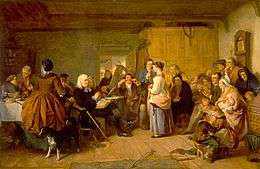Catechesis

Catechesis (/ˌkætəˈkiːsɪs/; from Greek: κατήχησις, "instruction by word of mouth", generally "instruction")[1][2] is basic Christian religious education of children and adult converts to Christianity. As defined in the Catechism of the Catholic Church, paragraph 5 (quoting John Paul II, Apostolic Exhortation Catechesi tradendae 18):
Catechesis is an education in the faith of children, young people and adults which includes especially the teaching of Christian doctrine imparted, generally speaking, in an organic and systematic way, with a view to initiating the hearers into the fullness of Christian life.
In Roman Catholicism, catechists are typically lay ministers trained in the art of catechesis. It might also be a pastor or priest, religious teacher, or other individuals in church roles (including a deacon, religious brother or sister, or nun). The primary catechists for children are their parents[3] or communities.[4]
History
In the early church, new converts, referred to as "catechumens," were instructed (catechized) in the basic elements of the faith such as the Apostles' Creed, Lord's Prayer, and sacraments in preparation for baptism.[5] During the fourth and fifth centuries, baptism had become a several-week-long rite leading up to the actual baptismal washing on Easter. During this time, catechumens attended several meetings of intensive catechetical preaching, often by the bishop himself, and often accompanied by special prayers, exorcisms, and other rites.[6] Catechumens recited the Apostles' Creed on Holy Saturday to show that one had completed their catechetical instruction.[7] By the sixth century, most of those presented for baptism were infants, and prebaptismal catechesis was abandoned. The decline of preaching and education in general following the barbarian invasions also influenced the decline of catechesis.[8] Later, instructors (catechists) would also teach Christians who had been baptized as children. The word "catechism", for a manual for this instruction appeared in the Late Middle Ages. During this time the instruction was also expanded to include memorization of the Lord's Prayer and Apostles' Creed, and some clergy probably provided expositions of this material in addition to the Ten Commandments. The main function of catechesis during this period was preparation for confession by enabling the Christian to identify their sins.[5]

Jean Gerson's L'ABC des simples gens was an important catechetical work published at the advent of the printing press which, along with Gerson's other catechetical works recognized the unique problems of teaching the faith to children.[9] Sixteenth-century Christian humanists considered the reform of catechesis to be a high priority.[10] One of these, Bishop of Basel Christoph von Utenheim, in one of the most successful efforts to revive catechesis, attempted to have regular catechetical preaching instituted throughout his diocese.[9] Johann Geiler von Kaisersberg was another popular preacher who followed the tradition of Gerson by preaching on the basics of the faith.[11] During the Protestant Reformation, the Reformers insisted that the Lord's Prayer and other forms be memorized in the vernacular language rather than Latin, which was the practice among Roman Catholics.[5] The use of a question and answer format was popularized by Martin Luther in his 1529 Small Catechism. He wanted the catechumen to understand what he was learning, so the Decalogue, Lord's Prayer, and Apostles' Creed were broken up into small sections, with the question "What does this mean" following each portion.[12]
See also
References
- ↑ κατήχησις. Liddell, Henry George; Scott, Robert; A Greek–English Lexicon at the Perseus Project.
- ↑ "catechesis". Online Etymology Dictionary.
- ↑ Luther 1959, p. 342.
- ↑ Manternach 1991, p. 23.
- 1 2 3 Green 1996, pp. 14–15.
- ↑ Old 1992, p. 3.
- ↑ Old 1992, p. 7.
- ↑ Old 1992, p. 17.
- 1 2 Old 1992, p. 181.
- ↑ Old 1992, p. 180.
- ↑ Old 1992, p. 182.
- ↑ Green, p. 17.
Bibliography
- Green, Ian (1996). The Christian's ABC: Catechisms and Catechizing in England c.1530-1740. Oxford: Clarendon Press – via Questia (subscription required) .
- Luther, Martin; Theodore G. Tappert Ed. (1959). The Book of Concord the confessions of the Evangelical Lutheran Church.
Luther's Small Catechism Art. i. Philadelphia: Mühlenberg Press. p. 342. In the Plain Form in Which the Head of the Family Shall Teach Them to His Household
- Manternach, Janaan; Pfeifer, Carl J. (1991). Creative catechist: a comprehensive, illustrated guide for training religion teachers (2 ed.). Twenty-Third Publications. p. 23. ISBN 978-0-89622-490-2. Retrieved 2010-11-06.
The life of the community and its diverse individuals now are seen as both the primary curriculum and the primary catechist.
- Old, Hughes Oliphant (1992). The Shaping of the Reformed Baptismal Rite in the Sixteenth Century. Grand Rapids, MI: William B. Eerdmans Publishing Company. ISBN 978-0802824899.